Day 1 of a five day Spring Migration tour today. A few migrants are continuing to get through, despite the rather unseasonably cold weather at the moment, so we set off east along the coast to try to catch up with some of them.
We made a brief stop at Cley on the way. A Wryneck has been in various gardens here for five days now, and was reported briefly first thing again today. By the time we arrived, it had not been seen again for a couple of hours. We had a quick look in the garden where it was seen yesterday, but as there was no sign of it there we decided not to hang around as we had other places we wanted to visit.
Our first destination proper was Kelling. The walk down the lane was rather quiet and fewer warblers than normal were singing in the cold wind. We did hear a Goldcrest singing and it was kind enough to come out and show itself. Further down, by the Water Meadow, there were several Common Whitethroat singing and one perched up nicely so we could see it, after performing a quick song flight. There was a nice ‘dopping’ of Shelduck in one of the fields – they are often to be found flying around here looking for burrows in which to nest.
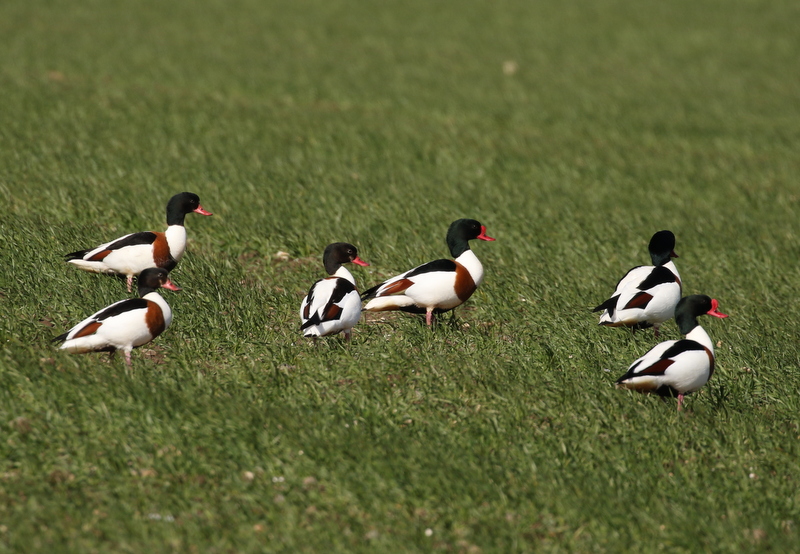 Shelduck – this ‘dopping’ was in a field by the Water Meadow
Shelduck – this ‘dopping’ was in a field by the Water Meadow
There has been a Ring Ouzel or two in the area here for about a week now. They seem to be lingering, presumably waiting for conditions to improve for their onward journey to Scandinavia. A quick scan along their favoured hedge revealed a single Ring Ouzel hopping about on the short grass. A bit like a Blackbird, through the scope, we could see the distinctive white crescent on the breast. A few Wheatear could be seen distantly in the same field.
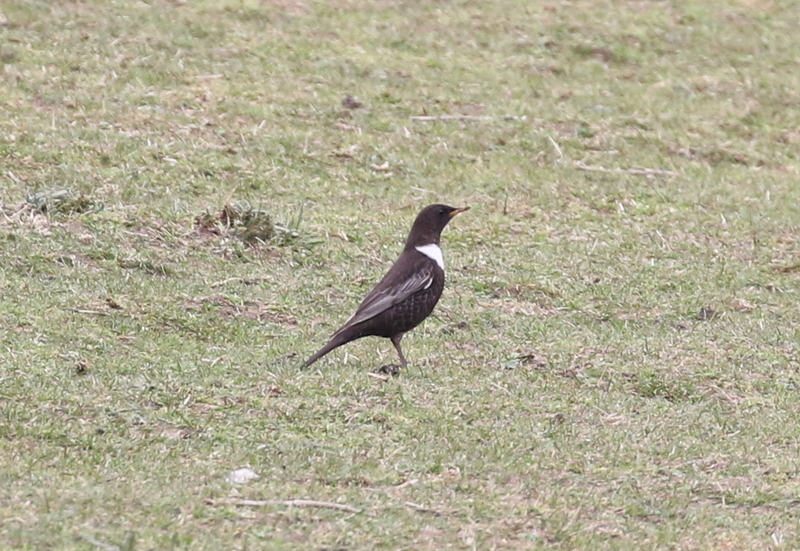 Ring Ouzel – a photo from a couple of days ago here
Ring Ouzel – a photo from a couple of days ago here
A scan of the Water Meadow produced the usual selection of wildfowl – the pair of Egyptian Geese with four goslings, a few Shoveler swimming round with their heads down and three Teal hiding in the vegetation round the edge. This despite the best efforts of the male Egyptian Goose, which seems intent on chasing away all the ducks, as they obviously pose a grave threat to his offspring!
As we stood looking at the Water Meadow, we heard a Yellow Wagtail call and turned to see it flying low over the grass. It circled once, then flew up and made to carry on west, but once it felt the strength of the wind it turned back and dropped down onto the grass. We just had time to get it in the scope – a smart male, with bright yellow head and underparts – before it was off again.
A tern appeared briefly overhead – it seemed to come from inland and continued straight on towards the sea. It was an Arctic Tern, with very buoyant flight and long tail. They have been on the move this week and several groups have been seen inland at various lakes and gravel pits. A nice surprise here on the coast.
There were a few waders on the pool – a pair of Avocets and a couple of Redshank. Another birder, walking ahead of us, flushed a Common Sandpiper from the far corner which thankfully landed back on the edge with the Avocets. We got it in the scope and watched it bobbing its way along the side of the pool.
We stopped to have a closer look at a couple of Skylarks out on the short grass. There are always lots of Meadow Pipits here, one of which entertained us with its parachute display flight. Several Linnets were in the bushes, a Reed Bunting called from the reeds and a smart male Stonechat perched on a fence post.
We were almost down to the beach when a shout from a local birder halfway up the hillside alerted us to a Cuckoo. We raced up and there was no sign of it at first where it had landed, but then it flew out of the bushes pursued by a couple of Meadow Pipits and circled round before disappearing over the brow. We continued on to the top of the ridge but couldn’t find it again. However, we did find three Wheatears in the top of the sheep field, including a smart bandit-masked male. They were very close from this side and we got superb views through the scope.
 Wheatear – showing well in the sheep field
Wheatear – showing well in the sheep field
It was a bit exposed and windy up on the ridge here, so after a good look at the Wheatears we walked back down and started to make our way back up the lane. Rounding the corner by the Water Meadow, we flushed a Ring Ouzel from the top of the brambles. A quick scan from round on the other side confirmed there were actually two of them still here today, with the Ring Ouzel we had seen earlier still present further along, where we had left it.
While we had been at Kelling, news had come through of a pair of Garganey freshly arrived at Felbrigg Park. As it is only a short drive from here, we decided to go there to try to see them.We could hear a Nuthatch in the trees as we walked down towards the lake, a Jay flew across, a female Kestrel perched high in a tree in a sheltered spot scanning the grass below and a pair of Mistle Thrushes were feeding out in the meadow.
It didn’t take long to find the Garganey, in the flooded meadow just before we got to the lake. They were feeding in amongst the vegetation at first, but as we stood and watched they came out into the open. We could see the striking white stripe on the head of the male.
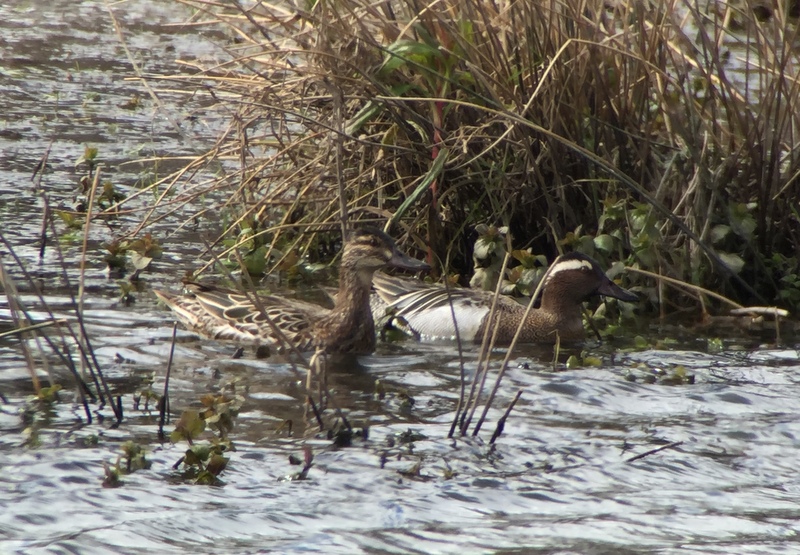 Garganey – this pair were in Felbrigg Park today
Garganey – this pair were in Felbrigg Park today
After watching the Garganey for a bit, we set off for a walk round the lake. There were lots of Sand Martins hawking for insects over the meadows and the water, plus a couple of Swallows. Apart from a few Tufted Duck and Teal, plus the usual Mallards, there weren’t many ducks on here today. Down by the meadows on the far side, we heard the yaffle of a Green Woodpecker and turned to see it perched down on the grass, catching the sun.
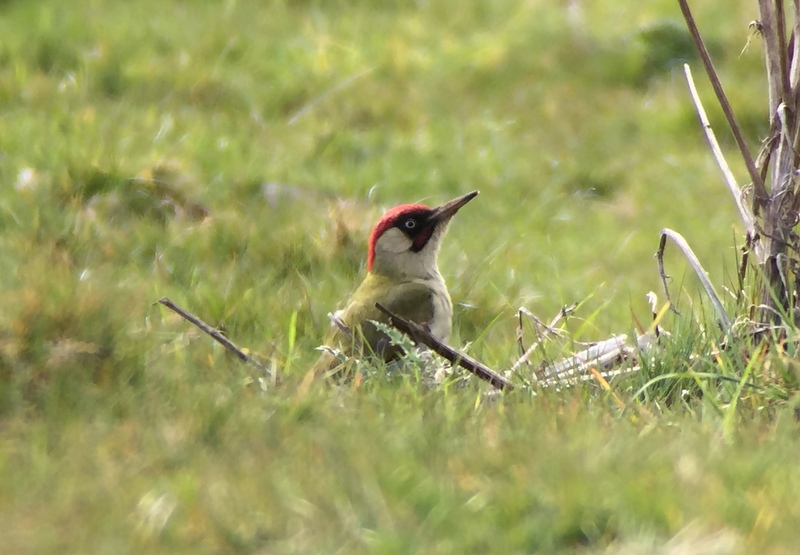 Green Woodpecker – out on the grass beyond the lake
Green Woodpecker – out on the grass beyond the lake
There were a few tits in the trees as we walked back through the woods on the other side of the lake. A pair of Marsh Tits were the highlight here – we could hear them calling as they worked their way through the trees towards us. A Great Spotted Woodpecker called from deeper in the wood. A couple of Chiffchaffs were singing.
On the walk back past the flooded meadow, the Garganey were still present, hiding in the vegetation again. A couple of Common Snipe dropped in and disappeared straight into cover, but eventually one just showed itself. Then it was back to the car for a late lunch. While we were eating, a pair of Nuthatches were calling from the trees just above us.
 Nuthatch – a pair were in the trees above us at lunchtime
Nuthatch – a pair were in the trees above us at lunchtime
After lunch, we dropped back down to Cley. The Wryneck had been seen again at one point during the morning, but had now disappeared again. However, a Temminck’s Stint had put in an appearance out on the reserve, so we decided to go to look for that instead. We had been advised to go to Bishop Hide first. On the walk there, we saw a Spoonbill flying off west across the reserve.We could hear Sedge Warblers singing, but they were mostly keeping tucked down out of the wind today. Eventually we found one singing from the safety of a bramble bush beside the path.
 Sedge Warbler – mostly singing from deep in the bushes today
Sedge Warbler – mostly singing from deep in the bushes today
There were a few raptors up now in the sunshine. A Common Buzzard was circling over the fields just the other side of the road and a Marsh Harrier was over the reeds. When we got a bit closer to the latter, we could see it was a male Marsh Harrier carrying nest material. It dropped into the reeds and flushed a female, which circled for a while before flying back to the nest and ousting the male.
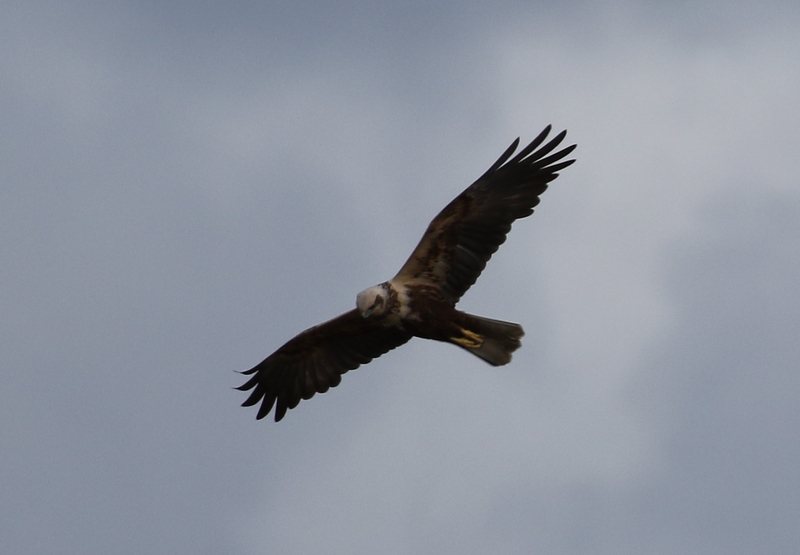 Marsh Harrier – a female circled over the reeds
Marsh Harrier – a female circled over the reeds
When we got in to Bishop Hide, we quickly found the Temminck’s Stint – but it was right over the other side in front of Teal Hide. We had a quick look at it through the scope anyway, in the heat haze, but it was not a great view. There were several other species of wader on here too – plenty of Avocets and a good number of Black-tailed Godwits.
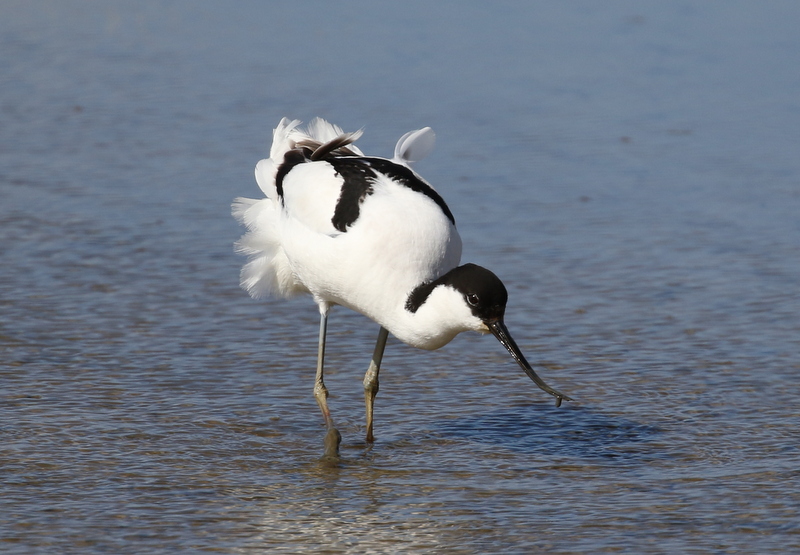 Avocet – feeding in front of Bishop Hide
Avocet – feeding in front of Bishop Hide
There were also a few Ruff. As waders go, Ruff are one of the most confusing at the best of times. But with the males in various stages of moult into summer plumage, the colours of which are hugely variable, no two look alike at the moment!
 Ruff – several today, but no two looking alike!
Ruff – several today, but no two looking alike!
We decided to make our way round to Teal Hide for a better look at the Temminck’s Stint. On the way, we could hear Bearded Tits calling from the reedbed. Thankfully when we got round there, the Temminck’s Stint was still where we had last seen it, on the island in front of Teal Hide. We had much better views of it from here, creeping round on the mud, before something spooked it and it flew off further away.
 Temminck’s Stint – much better views from Teal Hide
Temminck’s Stint – much better views from Teal Hide
We had seen most of the birds on here from the other side, but a few more Ruff added to the variety in this species we had observed today. A single Greenshank was feeding in the corner of the scrape, looking very elegant next to the larger, dumpier godwits. A Grey Heron was stalking along the edge of the reeds at the back, neck outstretched, looking for something to catch. A Water Rail squealed from the reedbed. A Brown Hare ran along the bank in front of the hide until it saw everyone inside, then turned and sprinted off in the other direction.
We had a look in Dauke’s Hide, but the water level on here has risen in the past few ayds and there was very little on the scrape here today, apart from the ubiquitous Avocets and Black-tailed Godwits. A pair of Shoveler dropped into the channel in front of the hide and the female swum straight in to the near bank without any fear while the male lurked further over calling nervously. We could see their enormous shovel-like bills.
 Shoveler – sporting a huge shovel-like bill
Shoveler – sporting a huge shovel-like bill
On the way back, we just had time for a quick last look in the gardens as we walked past, but there was still no sign of the Wryneck in any of its favourite spots. Then we headed for home.
















